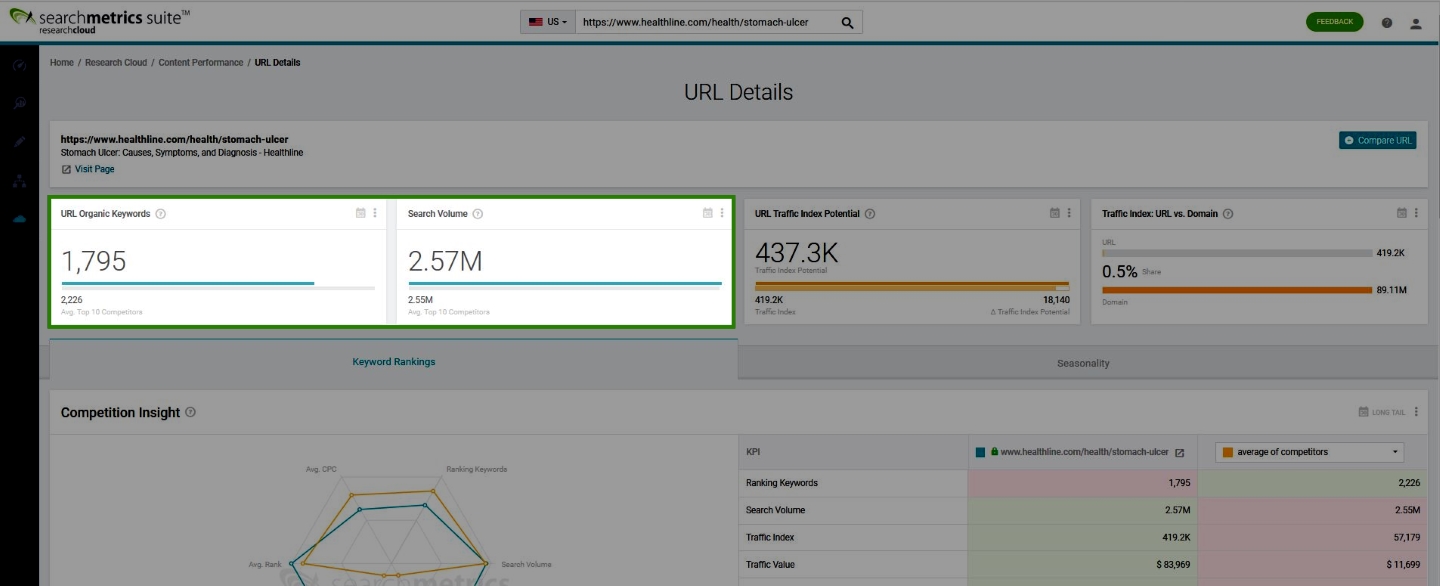Have you invested in producing great content, but then been disappointed with the page performance? Are you unhappy with your SEO traffic and organic rankings? Maybe your pages aren’t converting at the rate you would like? In this post, we’ll show you how content optimization works, and how you can get some quick wins to boost your rankings and on-page conversions.
If you’re looking for support with the content optimization of your website, we can offer the expertise you need. Why not get in touch and see how we can help you get started?
The Basics of Content Optimization
The starting point of content optimization is to regularly check whether your content needs updating. To do this, you can audit your rankings and content either manually or with the help of a software solution. Points to check include the following:
- Competitor Analysis: Has your competitive environment changed in any way? Have your competitors had new content ideas? Have your competitors extended, changed or restructured their content? Or has a competitor relaunched their website? Use findings from this investigation to adapt your own content accordingly.
- Search engine results page layout: Google is constantly testing new elements on the search results page. New ad formats or widgets can dramatically alter the search results and provide new opportunities for rankings and/or increased click-through rates. An example is the schema.org FAQ mark-up that was introduced for Rich Snippets in 2019. You should keep an eye on how the search results pages look for any keywords that you are thinking of optimizing your existing content for.
- Topic changes: Have there been developments in the topic that you could integrate into the content on your relevant landing page? Do users have new questions regarding this topic? Maybe users’ opinions on the topic have changed? Or perhaps there are new products or manufacturers that should be included in your content? All of these questions should be considered when optimizing your content.
- Ultimately, a website has to stay up-to-date on a topic to maintain long-term success – otherwise your pages will inevitably slide down the rankings.
Which pages have optimization potential?
To find out which landing pages can be usefully adapted, you can use the Content Performance feature within the Searchmetrics Research Cloud. This will show all the keywords for which a URL ranks in the search results.

- Now you can identify URLs that are currently ranking in high-potential positions. Any ranking from positions 6 to 20 in the search results can be considered high-potential. These pages are probably already generating some traffic, and Google is signalling that they are doing some things right i.e. the content is good, but could be better. Improving the content on these pages can lead to noticeable jumps in rankings that can have a meaningful impact on your traffic.
- You can also look at data for historical ranking trends: Look for URLs that have recently dropped down the rankings and that you consider valuable.
- It can also be useful to sort by search volume. This lets you find out which URLs you could optimize for the biggest impact on your online visibility. An improved position in the search results for a topic with high search volume can create a significant increase in your organic traffic.
- You can read more about identifying your optimization potential with the Research Cloud in our how-to guide.
- Two other useful sources of information are the Google Search Console and Google Analytics, where you can get data on user signals that can point to which pages it would be worthwhile optimizing. Are there any pages with an unusual impressions-to-clicks ratio? How can I improve my click-through rate – e.g. by optimizing the snippets that are displayed in the SERPs? Which pages are falling short of their conversion goals? Do I have pages with a comparatively low time on site, suggesting that users are frequently leaving the page without reading (much of) the content?
You can also set up your own individual benchmarks and KPIs, which may be useful for determining which pages to optimize. Find out which landing page is generating the most leads, or the most sales, and use content optimization to target the improvement of these metrics.
Which content should I optimize on my landing page?
By this stage, you should have selected a landing page and decided that its content needs updating. That’s great. Now you have to establish which topic clusters are missing from the content and whether there are any current points of interest that should be included. There are very few topics that stay unchanged year in, year out – new products appear, markets change, online competitors emerge, user habits develop. And landing pages should be kept up-to-date in line with the latest changes.
Which phrases appear in Google Suggest? As you type a keyword into the search bar, Google automatically generates suggestions for how you might like to complete your search query. These suggestions reveal current trends – as they are based on what users are searching for in relation to the main topic – and which aspects of a topic are relevant and could be covered by the content on your landing page.
Which “related searches” and “people also ask” results does Google display? Two more widgets on the search results page can be used to find possible content gaps on your website. The related questions box, with the heading “People also ask” includes several questions and answers in an accordion containing Featured Snippet-style results. Under “Searches related to” at the bottom of the page, you can also gain insight into trends and questions that are of (current) interest to users searching for this topic.
What is the search intent behind my topic? Although online marketers now have access to vast quantities of data that enables them to analyze myriad aspects of user behavior, there is still often a knowledge gap regarding what a user wants when they visit a page. Is the user looking for advice on a purchase or are they just trying to get basic information on a topic? Intents can also change over time as they are influenced by developments in consumer behavior, trending topics or new products. For this reason, it’s a good idea to check the user intent to see whether your content is still relevant for the main reason users are visiting your page. The Searchmetrics Suite makes it possible to find out the intent behind search queries relevant to your website – sorted into navigational, informational and transactional search queries at the keyword, URL, tag or project level.

Content optimization is creative work: Topic, keyword and search intent research don’t change the fact that writing and optimizing content is still a creative task! And of course, every topic is different, meaning that there is no one-size-fits-all SEO strategy for optimizing all your content. To optimize content well, you need expertise, a passion for the subject and an understanding of what your users want – and then you need to back this up with reliable data and a software-driven approach!
How can a competitor analysis help me optimize my content?
With a data-driven approach, you can gain valuable insights into your competitors. This is possible by running a content gap analysis, using a solution such as the Searchmetrics Suite. There are two strategies for an analysis of this kind:
- You can analyze a URL in the Searchmetrics Content Experience to see whether it matches your competitive environment. It’s possible that you are missing some must-have keywords – meaning that there are topic clusters your competitors are covering that you’re not. Or the focus of your content might not be up-to-date because it includes lots of topics and keywords that are no longer needed for a top ranking.
- You can make use of the competitor comparison at URL level in the Content Performance section of the Searchmetrics Research Cloud. If you know who your URL-level competitors are, what they are doing better and which keywords they rank for that you don’t, then you have a host of valuable information you can use when optimizing your own content.
It can also help to conduct a manual analysis of your competitors by taking a look at the search results yourself, in order to get a closer understanding of changes that are taking place. When analyzing the search results, you should focus on two points:
- How do your competitors’ snippets appear in the SERPs? Do the snippet titles include questions, calls-to-action, prices or other relevant points? Is there a competitor with a particularly catchy Meta Description? Is anyone using emojis? Are schema.org elements displayed as Rich Snippets in the search results e.g. showing review scores, prices, FAQs? On the basis of this analysis, you can create your own snippet and make it irresistible to users. You can see how successful you’ve been by tracking your click-through rates and rankings positions.
- How are your competitors’ pages structured? Which content elements are your online rivals using? What do they present in the above-the-fold area of their pages? Which calls-to-action have they chosen? Take the time to thoroughly analyze how your competitor’s pages are structured – and consider what would be useful for your users.
5 Quick Wins for your Content Optimization
- Identify your URL with the highest potential: Find out which of your URLs is the most valuable. Maybe you have some landing pages that have recently lost ranking positions? Or you could see which URL is occupying a high-potential position for a keyword with high search volume. Then get optimizing.
- Optimize your snippets: Hand on heart, when’s the last time you touched the Page Title and Meta Description of the landing page you want to optimize? Try out different phrases, maybe include the current year in the title. Look at the snippets your competitors have in the search results. See if schema.org mark-up could be used to generate Rich Snippets. Something as simple as republishing your content with an updated date can have a huge impact on your CTR in the SERPs.
- Look at competitor pages: Visit the landing pages of your direct competitors. Check to see if they have made any recent changes. Take a close look at all the elements on the page – you will have to go a long way to find a better source of inspiration for optimizing your own content!
- Win Featured Snippets: Does your target keyword set contain a lot of queries for which Google displays a Featured Snippet? If it does, then the aim of your optimization should be winning this Featured Snippet and getting the traffic it brings. Create trigger headings and structure your content in formats that are supported by Featured Snippets i.e. short paragraphs, lists and tables.
- Integrate news: Have there been any recent developments in your industry? How are your topics changing? Put new events and up-to-the-minute information in the landing page you want to optimize. Show Google – and show your users – that you are an expert in the topic of your website!
Want to start applying your SEO knowledge in practice? Then arrange your personal Searchmetrics Suite software demo today:
